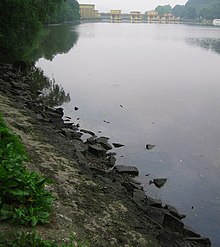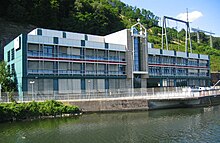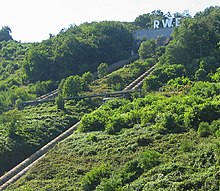Koepchenwerk
| Koepchenwerk | |||
|---|---|---|---|
| View from the south over the Hengsteysee to Koepchenwerk (right) and PSW Herdecke (left) | |||
| location | |||
|
|
|||
| Coordinates | 51 ° 24 '41 " N , 7 ° 27' 14" E | ||
| country | Germany | ||
| Waters | Hengsteysee ( Ruhr ) | ||
| Data | |||
| Type | pumped storage power plant | ||
| power | 153 MW | ||
| owner | RWE | ||
| operator | RWE | ||
| Project start | 1927 | ||
| Start of operations |
January 28, 1930 (old work) August 8, 1989 (new work) |
||
| Shutdown | 1994 (old work) | ||
| turbine | Francis pump turbine | ||
| Website | www.rwe.com | ||
The Koepchenwerk is one of the first two large pumped storage power plants to be built in Germany at the same time . It is located on the Hengsteysee in the city of Herdecke in North Rhine-Westphalia .
The owner of the power plant, named after its planner Arthur Koepchen and commissioned in 1930, was the RWE Group until the end of 2016 . Between 1985 and 1989, the modern power plant was built right next to the old plant on the lake shore.
This monument has been owned by the Foundation for the Preservation of Industrial Monuments and Historical Culture since January 2017 .
history
construction
The pumped storage power plant was built between 1927 and 1930 by the Rheinisch-Westfälische Elektrizitätswerk Essen (RWE) to supply power to the nearby Ruhr area on the steep slope of the Ardey Mountains directly on the Hengsteysee on the Ruhr . The Herdeck power plant was named after Arthur Koepchen .
With the Saxon pump storage plant Niederwartha , the engineers of the Koepchenwerk fought a real race for the first commissioning. Finally, the Niederwartha PSW went online with one machine on November 27, 1929, but its final completion and commissioning of the last machine set did not take place until March 1930. The Koepchenwerk was fully commissioned on January 28, 1930 with 132 megawatts . Logically - depending on the point of view - both power plants were celebrated as “first of their kind” and “great technical innovation”.
Second World War
Under the target number “B 28” (from 1941: GO 1123) the Koepchenwerk was on the target lists of the British Bomber Command even before the outbreak of World War II . Until April 1940 it was an important potential target in the "Ruhr Plan". By destroying power plants in the Rhineland and Ruhr area, the German arms industry was supposed to be switched off.
The “Ruhr Plan” lost its importance in the spring of 1940 because it was recognized that small targets such as power plants could not be located at night. Nevertheless, British bombers carried out at least four targeted air strikes on the Koepchenwerk, especially in the autumn. At the end of October 1940, a water pipe was damaged.
In order to protect the Koepchenwerk from air raids, it was hidden under camouflage nets from 1942 onwards. Numerous anti-aircraft batteries were stationed in the vicinity of Lake Hengstey . Barrier balloons were supposed to protect the plant from low-level attacks.
Due to the flooding of the turbine house after the bombing of the Möhne dam on May 17, 1943, it was down for several weeks. An American air raid on March 23, 1945 on the neighboring Hagen-Hengstey marshalling yard led to the destruction of open-air systems on the premises of the distribution station and the camouflage nets to fire.
New construction and modernization
In the post-war period, the Koepchenwerk worked largely without any problems. In December 1980, however, there was an accident when the housing of one of the pumps ripped. The attention of the operating team prevented consequential damage, but the investigations showed the imminent danger of similar damage to two other pumps. RWE therefore decided in 1981 to build a new pumped storage power plant, the PSW Herdecke , at the same location and to shut down the old plant.
Between 1985 and 1989, the modern power plant was built right next to the old plant on the lake shore. This continues to use the same principle. The most noticeable difference, apart from the new power plant building, is that the pressure pipes now run underground and are no longer visible.
In 2007 the owner RWE invested 25 million euros in modernizing the power plant in Herdecke. The work lasted from May to September 2007.
On January 12, 2015, RWE, as the lower monument authority, submitted a demolition application for the listed facilities to the city of Herdecke . In 2016, the Foundation for the Preservation of Industrial Monuments and History Culture took over the plant as its foundation property. From 2017, the property was then secured in accordance with the requirements of a monument. In February 2020, the power plant was named Monument of the Month in Westphalia-Lippe by the LWL Monument Preservation, Landscape and Building Culture in Westphalia .
technology
The new power plant built in the 1980s is, like the old one, a peak load hydropower plant . During periods of low electricity demand (mostly at night), water is pumped from the reservoir into the storage basin, which is a good 160 meters higher on a mountain. During periods of increased electricity demand (mostly during the day), the water then flows back into the lake through pipelines and a large reversible Francis pump turbine . As a result, up to 153 MW of electrical power can be produced for up to four hours today. The turbine can be run from standstill to full load within 70 seconds. The turbine itself is located in a shaft 42 meters below the water level of the lake.

The large difference in height results from the need to exclude any risk of cavitation when pumping . The shaft of the turbine and generator is arranged vertically, the rotor of the generator weighs over 300 tons . The connection to the upper water by a rock in the blown-up 396 meters long tunnel provided by a single pipe of nominal diameter leads DN 4750th At the inlet to the pump turbine there is a ball valve with a nominal width of DN 3300, which at the time of its manufacture was the largest of its kind in the world. The valve can be closed with hydraulic cylinders within 32 seconds.
The start-up of the entire system in pumping mode is made possible by a frequency converter with 20 MW output. This frequency converter is currently still the largest in Europe .
The storage basin, which is adapted to the hilltop, has a length of approx. 600 meters and a width of approx. 250 meters and a capacity of over 1.5 million m³. The concrete surfaces in and around the reservoir were renovated in 2007.
The grid connection is made via the Garenfeld switchgear at the 220 kV maximum voltage level in the grid of the transmission system operator Amprion .
| Technical data of the new power plant | |
|---|---|
| Content of the upper basin: | 1,600,000 m³ |
| Usable content: | 1,533,000 m³ |
| Drop height: | 165.2-145.5 m |
| Construction time: | 1985-1989 |
| Installation: | August 8, 1989 |
| Expansion flow in pumping mode: | 101.7 m³ / s |
| Expansion flow in turbine operation: | 110 m³ / s |
| Power in pumping mode: | 153.59 MW |
| Power in turbine operation: | 153 MW |
| Work content of the upper basin: | 649,000 kWh |
| Electrically usable work content: | 590,000 kWh |
| Max. Pump storage efficiency : | 80% |
| Speed of generator, pump and turbine: | 250 revolutions per minute |
ecology

Due to the daily pump storage operation, the water level of the Hengsteysee , which serves as the lower basin, can fluctuate by 70 cm within a short time (between +95.6 m above sea level and +96.3 m above sea level). This has significant consequences for marine ecology. The bank vegetation is correspondingly reduced and many birds that usually breed on the bank can only do this with great difficulty or only with artificial aids. In addition, smaller living beings (including fish) are caught in the suction of the pumps despite the screening devices and do not survive the power plant processes, especially the high pressures in the pipes.
Monument protection and tourism

The old system of the Koepchenwerk, with four machine sets with separate pumps and turbines as well as horizontal shafts , has been a listed building since 1986 . In 1994 it was finally shut down. The control technology of the control room was expanded and the pipes at the reservoir were sealed with concrete. Insights into the old turbine hall are possible from the sea. Information boards are accessible during general office hours and explain how the plant works.
The hall is generally closed to visitors and the foundation regularly offers guided tours.
The power station is part of the Herdecke Energy Management Trail and part of several themed routes on the Industrial Culture Route .
A branch path closed to public traffic leads to the storage basin on the mountain (accessible via a side street of the B 54 ), which can, however, be used by pedestrians to get to a viewing platform above the Ruhr valley. There is also a board with some information about the construction of the Koepchenwerk. There is no publicly accessible connection between the upper basin and the power plant on the lake. The steep wooded slope around the pressure pipes is cordoned off as RWE's premises.
Below the water locks on the upper basin are three large illuminated letters from the operator RWE, which were brightly lit at night until the beginning of the 1990s and were thus visible from afar as a landmark , including from the A1 .
About one kilometer downstream, at the end of the Hengsteysee, there is another power plant, the Hengstey run-of-river power plant .
Future of the plant
In 2015, plans by RWE became public, according to which the Koepchenwerk should be demolished. The planned demolition of the monument was averted. In 2016, the industrial monument was placed in the care of the Foundation for the Preservation of Industrial Monuments and History , which is maintained by the state of North Rhine-Westphalia and the RAG . After a comprehensive safeguarding of the plant was carried out from 2017, it is to be integrated into the local leisure and tourism offerings and be accessible to visitors as part of guided tours and events. An illumination based on a historical model is also planned, as is a central role in the International Garden Exhibition 2027 .
RWE radio tower
The facility also includes a 79-meter-high radio tower built as a reinforced concrete structure near the upper basin.
See also
literature
- Hans Dieter Dörre: Storage basins on the Kleff and Hengstey lakes - a concept is recognized in Europe - a structure erected in Herdecke at the end of the 1920s. - Article in: Herdecker Blätter. Issue 3 (May 1993), pages 9-14
- Ralf Blank: The city of Hagen in the bombing war . In: Gerhard E. Sollbach (ed.): Hagen 1939-1948. War and post-war period . Hagener Stadtgeschichte (n), Vol. 4. Hagen 1994. pp. 9-26.
- RWE Power AG: Herdecke pumped storage power plant , Essen
- Georg Maybaum: The effort to maintain the Koepchenwerk in Herdecke. In: Birgit Franz, Ingrid Scheurmann (eds.): Structural change - monument change. Reconstruction - conversion - reinterpretation . (= Publication of the working group Theory and Teaching of Monument Preservation, Vol. 25), Verlag Mitzkat Holzminden 2016, ISBN 978-3-95954-014-8 , pp. 120–128.
Web links
- 75 years of the Herdecke power plant - historical core, modern technology (June 2005). (PDF file; 329 kB)
- Metropolis Ruhr: The Koepchenwerk as a sight
- Description of all locations on this themed route as part of the Route of Industrial Culture
- Foundation for the preservation of industrial monuments and history culture Information and dates for guided tours
Individual evidence
- ↑ http://www.industriedenkmal-stiftung.de/docs/20376049561666_de.php
- ↑ http://www.rwe.com/web/cms/de/2720904/rwe-power-ag/energietraeger/wasserkraft/rwe-wasserkraftwerke/psw-herdecke/
- ^ A b Claudia Reck: Monument of the month: The Koepchenwerk pumped storage power plant in Herdecke. LWL monument preservation, landscape and building culture in Westphalia, accessed on March 6, 2020 .
- ↑ Federal Network Agency power plant list (nationwide; all network and transformer levels) as of July 2nd, 2012. ( Microsoft Excel file, 1.6 MB) Archived from the original on July 22, 2012 ; Retrieved July 21, 2012 .
- ↑ RWE wants to tear down landmarks like letters and pipes , article from March 10, 2015 by Steffen Gerber on Derwesten.de
- ↑ Koepchenwerk in Herdecke rescued , article from November 15, 2016 by Susanne Schlenga on DerWesten .de
- ↑ Koepchenwerk. Foundation ensures the preservation of an industrial monument in FAZ from November 18, 2016, page 9









